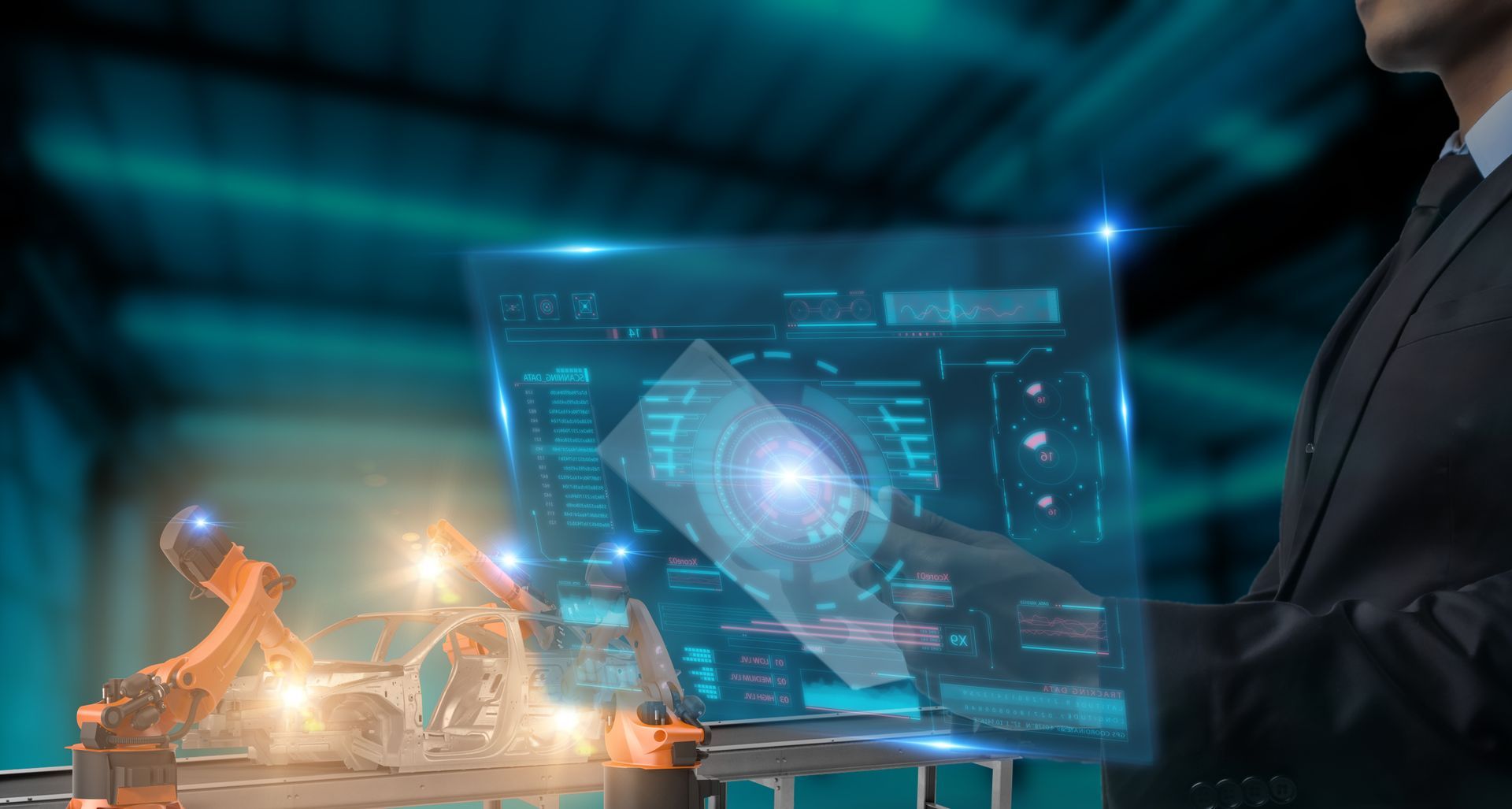
Insights
Government IT Innovators
Unlocking the Potential of Technology in Public Service

By Cordell Ennis
•
April 8, 2023
In the ever-evolving landscape of information technology, businesses face the constant challenge of delivering IT projects on time and within budget. Cost overruns on IT projects can have serious financial consequences for organizations and damage their reputation. To help you avoid these pitfalls, we've compiled a comprehensive guide with effective strategies for reducing cost overruns on IT projects.

By Larry White
•
March 24, 2023
Digital transformation is essential for businesses looking to remain competitive and adapt to changing market conditions. In this article, we explore the latest trends and predictions for the future of digital transformation, including artificial intelligence, cloud computing, the internet of things, big data analytics, and blockchain technology. We also discuss strategies for successful digital transformation, including prioritizing cybersecurity and sustainability, embracing automation, and personalizing the customer experience. Whether you're a business leader or simply interested in the latest technological advancements, this article provides valuable insights into the future of digital transformation and how to prepare for it.

By Larry White
•
February 8, 2023
Edge computing is a cutting-edge technology that is changing the way we interact with technology. It involves bringing computing and data storage closer to the edge of the network, where it is needed most, instead of relying on centralized servers located far away. The goal is to provide faster and more efficient processing of data, while reducing the amount of data that needs to be transmitted over long distances. In this comprehensive guide, we'll dive into the concept of edge computing, explore its benefits, and discuss the various applications and industries that are leveraging this innovative technology to stay ahead of the curve. What is Edge Computing? Edge computing is a decentralized approach to computing that aims to bring processing and data storage closer to the source of the data. This eliminates the need to transmit large amounts of data over long distances, reducing latency and improving processing speeds. Instead of relying on centralized data centers, edge computing leverages a network of small, low-power devices located at the edge of the network. Benefits of Edge Computing Edge computing offers a number of benefits over traditional centralized computing approaches. Some of the most notable benefits include: Reduced Latency: By bringing computing closer to the edge of the network, edge computing reduces latency, allowing for faster processing and decision-making. Improved Efficiency: Edge computing is more energy-efficient than centralized computing, as it requires less power to process and store data. Increased Reliability: By decentralizing data storage and processing, edge computing makes it more resilient to network outages or other disruptions. Reduced Costs: Edge computing reduces the cost of data storage and transmission, as well as the costs associated with maintaining and updating centralized data centers. Applications of Edge Computing Edge computing is being used in a variety of industries and applications, including: IoT: The Internet of Things (IoT) is a prime example of how edge computing can be leveraged to process and store large amounts of data generated by connected devices. Industrial Automation: Edge computing is being used to automate industrial processes and reduce the time it takes to process and analyze data from sensors and other sources. Transportation: Edge computing is being used in the transportation industry to improve efficiency and reduce costs by processing data from vehicles in real-time. Healthcare: Edge computing is being used in healthcare to improve patient outcomes by processing data from wearable devices and other sources in real-time. Key Players in the Edge Computing Market There are a number of key players in the edge computing market, including: Amazon Web Services (AWS): AWS is a leading provider of edge computing solutions, offering a range of services and tools designed to help organizations leverage this innovative technology. Microsoft Azure: Microsoft Azure is another major player in the edge computing market, offering a range of services and tools designed to help organizations process and store data at the edge of the network. Google Cloud: Google Cloud is a major player in the edge computing market, offering a range of services and tools designed to help organizations process and store data at the edge of the network. Conclusion Edge computing is a rapidly evolving technology that is changing the way we interact with technology. By bringing processing and data storage closer to the edge of the network, edge computing offers a range of benefits, including reduced latency, improved efficiency, increased reliability, and reduced costs. As more industries and applications adopt this technology, it is sure to play an increasingly important role in the digital landscape. In conclusion, edge computing has the potential to revolutionize the way we interact with technology and has already started making a significant impact in a number of industries. Whether you're in the IoT, industrial automation, transportation, or healthcare, there are a number of edge computing solutions that can help you stay ahead of the curve and achieve your goals. FAQs What is edge computing? Edge computing is a decentralized approach to computing that aims to bring processing and data storage closer to the source of the data, reducing latency and improving processing speeds. What are the benefits of edge computing? Edge computing offers a number of benefits over traditional centralized computing approaches, including reduced latency, improved efficiency, increased reliability, and reduced costs. What are some industries that are using edge computing? Edge computing is being used in a variety of industries, including IoT, industrial automation, transportation, and healthcare. Who are the key players in the edge computing market? There are a number of key players in the edge computing market, including Amazon Web Services (AWS), Microsoft Azure, and Google Cloud.

By Larry White
•
February 8, 2023
Artificial Intelligence (AI) is revolutionizing the way we live and work. With the advent of big data and the growth of computing power, AI is becoming increasingly sophisticated and more widely used. The driving force behind AI's rapid growth is data, which provides the raw material for the algorithms and models that power AI systems. What is Data and Why is it Important? Data refers to the raw information that is collected and analyzed to extract insights and drive decision-making. In the context of AI, data is the foundation upon which AI models are built. These models learn from data, using statistical methods and machine learning algorithms to identify patterns and make predictions. The quality of data that is used to train AI models has a significant impact on the accuracy and effectiveness of the models. Data must be clean, complete, and relevant to the problem being solved. Poor quality data can lead to poor results, and in some cases, AI systems can even perpetuate existing biases or discrimination. The Different Types of Data There are several different types of data that are used in AI, including: Structured Data: This type of data is well-organized and can be easily stored in a database. Examples of structured data include customer information, sales data, and financial data. Unstructured Data: This type of data is less organized and may include text, images, videos, and audio files. Unstructured data is more difficult to store and analyze, but it can provide valuable insights when processed by AI systems. Semi-Structured Data: This type of data has some elements of structure, but it is not as organized as structured data. Semi-structured data can include email messages, social media posts, and customer reviews. The Benefits of Using Data in AI The use of data in AI provides numerous benefits, including: Improved Decision-Making: By analyzing large amounts of data, AI systems can provide insights and recommendations that are more accurate and relevant than those generated by humans. Increased Efficiency: AI systems can automate repetitive and time-consuming tasks, freeing up time for more strategic and creative work. Enhanced Customer Experience: AI systems can be used to provide personalized experiences for customers, such as personalized recommendations or chatbots that provide real-time support. Better Predictive Analytics: AI systems can analyze patterns in data to make predictions about future trends and behaviors. This can help organizations to make better decisions and respond more quickly to changing market conditions. The Challenges of Using Data in AI Despite the many benefits of using data in AI, there are also several challenges that organizations must overcome: Data Privacy and Security: The large amounts of sensitive data that are collected and processed by AI systems pose significant privacy and security risks. Data Bias: AI systems can perpetuate existing biases in data, leading to discriminatory outcomes. Data Quality: Poor quality data can negatively impact the accuracy of AI models, leading to poor results. Data Governance: Ensuring that data is collected, stored, and processed in a responsible and ethical manner is a complex and ongoing challenge for organizations. Conclusion Data is the fuel that drives AI and is critical to its success. However, organizations must carefully manage the quality and security of their data to ensure that AI systems deliver the desired results. By overcoming the challenges of using data in AI, organizations can realize the full potential of this technology to improve decision-making, increase efficiency, enhance the customer experience, and support predictive analytics.

By Larry White
•
February 8, 2023
Cloud technology has become increasingly popular for businesses of all sizes, providing them with greater flexibility and scalability for their IT systems. However, the use of cloud technology has also raised concerns about the security of sensitive data and the potential risks posed by cyber threats. In this article, we will explore the key considerations for cloud and infrastructure security and offer practical advice on how to secure your business against cyber attacks. What is Cloud and Infrastructure Security? Cloud and infrastructure security refers to the measures and practices used to protect cloud-based systems, networks, and data from unauthorized access and potential threats. This includes protecting against malicious software, hacking attempts, and data breaches, as well as ensuring the security of cloud-based applications and services. Why is Cloud and Infrastructure Security Important? With the increasing use of cloud technology, it is essential for businesses to be aware of the potential risks and to take the necessary steps to protect their sensitive data and systems. Cyber threats are constantly evolving, and businesses that do not take the proper precautions can become vulnerable to data breaches, loss of sensitive information, and reputational damage. In addition, the consequences of a security breach can be significant, including financial loss, legal penalties, and loss of customer trust. Key Considerations for Cloud and Infrastructure Security There are several key considerations that businesses need to keep in mind when it comes to cloud and infrastructure security, including: Encryption: Encrypting sensitive data, both in transit and at rest, is one of the most important measures for protecting your cloud-based systems and data. Access controls: Implementing strong access controls, such as multi-factor authentication, is crucial for preventing unauthorized access to cloud-based systems and data. Threat detection and response: Having a robust threat detection and response plan in place is essential for quickly identifying and mitigating potential threats to your cloud-based systems. Continuous monitoring: Regular monitoring of cloud-based systems is important for identifying and addressing potential security risks in a timely manner. Third-party security: If you use third-party cloud-based services, it is important to ensure that the provider has robust security measures in place and to regularly assess the security of these services. Best Practices for Cloud and Infrastructure Security To ensure the security of your cloud-based systems and data, it is recommended that you follow the following best practices: Regularly update software and security protocols: Keeping software and security protocols up-to-date is important for protecting against known vulnerabilities and potential threats. Use secure passwords: Using strong and unique passwords is essential for preventing unauthorized access to cloud-based systems and data. Limit access to sensitive data: Limiting access to sensitive data to only those who need it is important for reducing the risk of data breaches. Regularly backup data: Regularly backing up data is important for ensuring that you can quickly recover from a security breach or data loss. Conduct regular security assessments: Regular security assessments can help you identify potential security risks and ensure that your security measures are effective. Conclusion Cloud and infrastructure security is a crucial consideration for businesses of all sizes, and it is essential to take the necessary steps to protect your sensitive data and systems from potential cyber threats. By following best practices, such as encryption, access controls, and regular monitoring, businesses can reduce the risk of security breaches and ensure the protection of their valuable assets. FAQs What is cloud and infrastructure security? 1. Cloud and infrastructure security refers to the measures and practices used to protect cloud-based systems, networks, and data from unauthorized access and potential threats, such as malicious software, hacking attempts, and data breaches. Why is cloud and infrastructure security important? 2.Cloud and infrastructure security is important because cyber threats are constantly evolving and businesses that do not take the proper precautions can become vulnerable to data breaches, loss of sensitive information, and reputational damage. The consequences of a security breach can be significant and can include financial loss, legal penalties, and loss of customer trust. What are the key considerations for cloud and infrastructure security? 3.The key considerations for cloud and infrastructure security include encryption, access controls, threat detection and response, continuous monitoring, and third-party security. What are the best practices for cloud and infrastructure security? 4.The best practices for cloud and infrastructure security include regularly updating software and security protocols, using secure passwords, limiting access to sensitive data, regularly backing up data, and conducting regular security assessments. Can regular security assessments help prevent security breaches? 5.Yes, regular security assessments can help prevent security breaches by identifying potential security risks and ensuring that security measures are effective. These assessments can also help businesses stay informed about new threats and vulnerabilities and take appropriate action to protect their systems and data.

By Larry White
•
February 8, 2023
Digital Twin technology is a cutting-edge innovation that is changing the way industries operate. It provides a virtual replica of a physical product, system, or process, allowing manufacturers, operators, and other stakeholders to monitor and optimize performance in real time. What is Digital Twin Technology? A Digital Twin is a virtual replica of a physical object, system, or process. It's created using a combination of sensors, software, and data analysis tools that provide real-time insights into the performance and behavior of the physical twin. Benefits of Digital Twin Technology The use of Digital Twin technology offers numerous benefits to industries across the board. Some of the most notable benefits include: Improved efficiency: Digital Twins allow industries to monitor and optimize performance in real time, leading to improved efficiency and reduced waste. Enhanced product development: By creating virtual prototypes, Digital Twins can accelerate product development and reduce the time and cost required to bring new products to market. Predictive maintenance: Digital Twins enable industries to predict when maintenance is required, reducing downtime and improving equipment reliability. Improved safety: By providing real-time insights into the behavior of physical systems, Digital Twins can help industries identify and mitigate safety risks. How Does Digital Twin Technology Work? The core components of Digital Twin technology include sensors, software, and data analysis tools. The sensors are placed on the physical object, system, or process, and they collect data in real-time. This data is then transmitted to the software, where it's analyzed and used to create a virtual replica of the physical object. The virtual replica is constantly updated as new data is received, allowing industries to monitor and optimize performance in real-time. This allows industries to make data-driven decisions that improve efficiency, safety, and performance. Applications of Digital Twin Technology Digital Twin technology has a wide range of applications across various industries, including: Manufacturing: Digital Twins can be used to optimize production processes, reduce waste, and improve the speed of product development. Healthcare: Digital Twins can be used to model the human body and simulate medical procedures, allowing healthcare providers to make more informed decisions and improve patient outcomes. Construction: Digital Twins can be used to manage construction projects, reducing waste and improving efficiency. Energy: Digital Twins can be used to optimize energy production and consumption, reducing waste and improving sustainability. Automotive: Digital Twins can be used to optimize vehicle design, improve fuel efficiency, and reduce emissions. The Future of Digital Twin Technology The future of Digital Twin technology is bright, and it's expected to have a major impact on the way industries operate in the years to come. As the technology continues to evolve and improve, it's likely that Digital Twins will become even more widely used, providing a virtual replica of almost every physical object, system, or process. Conclusion Digital Twin technology is a cutting-edge innovation that is changing the way industries operate. By providing real-time insights into the performance and behavior of physical systems, it enables industries to make data-driven decisions that improve efficiency, safety, and performance. With a wide range of applications across various industries, the future of Digital Twin technology is bright, and it's expected to have a major impact on the way industries operate in the years to come. FAQs 1.What is Digital Twin technology? Digital Twin technology is a virtual replica of a physical object, system, or process created using a combination of sensors, software, and data analysis tools that provide real-time insights into the performance and behavior of the physical twin. 2. What are the benefits of Digital Twin technology? The benefits of Digital Twin technology include improved efficiency, enhanced product development, predictive maintenance, and improved safety. 3.How does Digital Twin technology work? Digital Twin technology works by using sensors to collect data in real-time, which is then transmitted to software where it's analyzed and used to create a virtual replica of the physical object. The virtual replica is constantly updated, allowing industries to monitor and optimize performance in real-time. 4. What are some applications of Digital Twin technology? Some applications of Digital Twin technology include manufacturing, healthcare, construction, energy, and automotive.

By Duval Tyson
•
February 7, 2023
Human Capital Management (HCM) has become increasingly important in today's fast-paced and competitive business world. As organizations seek to attract, retain and develop the best talent, innovative HCM practices are more critical than ever. This article provides a comprehensive guide to innovative HCM, highlighting key concepts, strategies, and best practices. What is Human Capital Management? HCM is the process of managing people within an organization, including all aspects of human resources, payroll, benefits, and talent management. It is a critical component of overall business strategy, as a company's most valuable asset is its people. Why is Innovative HCM Important? In today's rapidly changing business environment, organizations must be nimble and adaptive to stay competitive. Innovative HCM helps organizations to attract, retain and develop the best talent, which in turn drives business success. Additionally, innovative HCM practices can improve employee engagement and satisfaction, resulting in increased productivity and profitability. Key Components of Innovative HCM Talent Management: A critical component of HCM, talent management involves attracting, developing and retaining the best talent. This includes identifying key talent, developing and implementing training and development programs, and offering competitive compensation and benefits packages. Employee Engagement: Engaging employees is crucial to their satisfaction and productivity. Innovative HCM practices focus on creating a positive and supportive work environment, fostering open communication, and offering opportunities for professional growth. Technology: Technology plays an increasingly important role in HCM, with a growing number of companies utilizing HR technology to automate and streamline processes such as payroll, benefits administration, and performance management. Data Analytics: The use of data analytics is crucial to the success of HCM. By gathering and analyzing data on employee performance, engagement, and satisfaction, organizations can make informed decisions and improvements to their HCM practices. Best Practices for Innovative HCM Develop a comprehensive HCM strategy: A well-defined and comprehensive HCM strategy is essential to the success of any organization. This strategy should outline the goals and objectives of the organization, and provide a roadmap for achieving these goals. Invest in HR technology: HR technology can greatly streamline and automate HCM processes, freeing up valuable time and resources for other critical business initiatives. Foster a positive and supportive work environment: By creating a positive and supportive work environment, organizations can improve employee engagement, satisfaction, and productivity. This can be achieved through open communication, flexible work arrangements, and opportunities for professional growth. Regularly gather and analyze data: Regular data collection and analysis is crucial to the success of HCM. This data can be used to make informed decisions and improvements to HCM practices. Continuously evaluate and improve HCM practices: Innovative HCM requires continuous evaluation and improvement. By regularly evaluating and refining HCM practices, organizations can stay ahead of the competition and continue to attract, retain and develop the best talent. Conclusion Innovative Human Capital Management is critical to the success of any organization in today's rapidly changing business environment. By focusing on key components such as talent management, employee engagement, technology, and data analytics, and implementing best practices such as developing a comprehensive HCM strategy, investing in HR technology, fostering a positive work environment, regularly gathering and analyzing data, and continuously evaluating and improving HCM practices, organizations can ensure they have the best possible talent driving their business success.
MENU
GET IN TOUCH
(833) 314-5623
info@globalonesolutions.co
923 Haddonfield Rd
Suite 300
Cherry Hill, NJ 08002
STAY CONNECTED

By Cordell Ennis
•
April 8, 2023
In the ever-evolving landscape of information technology, businesses face the constant challenge of delivering IT projects on time and within budget. Cost overruns on IT projects can have serious financial consequences for organizations and damage their reputation. To help you avoid these pitfalls, we've compiled a comprehensive guide with effective strategies for reducing cost overruns on IT projects.
© 2025
All Rights Reserved | Global One Solutions | Powered by Mahogany Sites.

